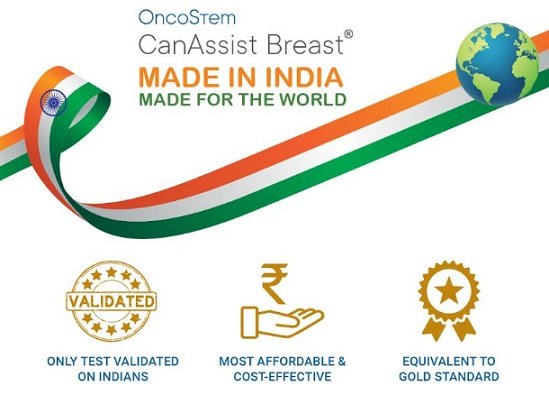New Study Reports OncoStem's CanAssist Breast Equivalent to Gold Standard

Bangalore, India: OncoStem Diagnostics, an oncology-focused company that enables personalised cancer treatment, has successfully completed its first-ever comparative study with the prognostic test Oncotype DX. The study, conducted using samples from OncoStem’s study partners in India, USA and Spain, was recently published in the journal “Cancer Medicine”. The performance of the two tests were found to be equivalent.
OncoStem’s CanAssist Breast is a prognostic test for early-stage hormone receptor-positive breast cancer patients. It makes customized treatment possible by analysing the patient's tumour in-depth, and providing a patient-specific report. CanAssist Breast categorizes patients based on the biology of the tumour as either ‘low or high’ risk for cancer recurrence/relapse. Patients who are at low risk of relapse can potentially avoid chemotherapy and its associated side-effects, while patients who are at high risk of relapse would benefit from the addition of chemotherapy to their treatment regimen. CanAssist Breast is the only prognostic test for early stage hormone receptor positive breast cancer to be developed and validated on Indian patients.
The study published in “Cancer Medicine” shows that the test has good concordance with Oncotype DX and comparable negative predictive value (NPV). The goal of the study was to compare the prediction of risk of breast cancer relapse between CanAssist Breast and Oncotype DX, the latter often considered as a gold-standard by many clinicians. The low-risk of recurrence category of the two tests show 83% concordance, with an over-all concordance of 75%. This is much higher than the published concordance values of other tests with Oncotype DX. The accuracy of the two tests as measured by the NPV of the low-risk categories was also comparable (93.4% for CanAssist Breast versus 91.8% for Oncotype DX).
A part of the comparative study data appeared in the Journal of Clinical Oncology as one of the shortlisted abstracts for the ASCO 2020 (American Society of Clinical Oncology) summit, an annual event that was held virtually this year.
Dr. SVS Deo, Professor & Head, Dept. of Surgical Oncology, AIIMS, New Delhi remarked, “The conventional approach of using all the drugs including chemotherapy, radiotherapy and major surgery is now witnessing a big shift because we have realized that not all patients are benefitting from these treatments. In a group of breast cancer patients only hormonal therapy is adequate and addition of chemotherapy is not benefitting them. Tests like Oncotype DX can be used to identify this group of patients, however they are not being utilized by a large number of breast cancer patients in India due to limited availability and cost factors. CanAssist Breast is a “Made in India” invention by OncoStem. When you compare CanAssist with Oncotype DX in the Cancer Medicine study, the performance was comparable. This is a significant breakthrough for breast cancer patient management in India.”
Dr. Harit Chaturvedi, Chairman of Max Institute of Cancer Care in Delhi, added, “If you look at the numbers, every 7 out of 10 patients eligible for a prognostic test can avoid chemotherapy, but in my experience, 95% of our patients don’t get the prognostic tests eg Oncotype DX done, because of the cost. With a more affordable test like CanAssist Breast, one will see a huge section of these patients cutting down on avoidable chemotherapy. The scientific maturity of our community also reflects well by bringing such a test into the game. CanAssist is validated on our population database and everything is in the Indian context.”
Speaking about the impact of this study, Dr. Manjiri Bakre, CEO and Founder, OncoStem Diagnostics said, “We believe this study will further boost the confidence of South Asian oncologists in using the affordable CanAssist Breast to assess the risk of recurrence of their early stage hormone receptor positive breast cancer patients, and thus help a large number of women avoid unnecessary chemotherapy.”















































